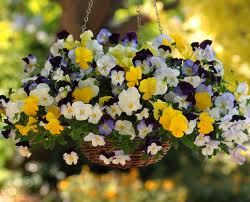 So you want some vines to plant around a fence, trellis or front porch. What should you get?
So you want some vines to plant around a fence, trellis or front porch. What should you get?
Vines come in two or three varieties- annual or perennial. Perennial vines like clematis, false hydrangea vine, trumpet vine, wisteria, hardy jasmine and honeysuckle come back every year, and may even stay somewhat evergreen over the winter. Like regular perennials, they have a limited bloom window, then quit.
Our Amish friends tend to grow the best-looking clematis I've ever seen- their secret is to add a small handful of lime to the soil at planting and then every year afterwards. Clematis come in three pruning groups- the ones that bloom on old wood and then are done, the ones that bloom on old wood, then get a second flush later in the summer and the ones that bloom on new wood, later in the summer. Knowing your bloom time, tells you when to prune.
One of my new favorites is Carolina Jessamine. It is a fragrant evergreen vine that blooms about now. It's great if your eyes can stand more bright yellow after the forsythias and daffodils. We have one planted below the deck and it has grown about 20 feet in the last 5 years. It is all budded and I am anxiously awaiting the bloom. It is evergreen, and the foliage bronzes over the winter.
Annual vines, like morning glories, cypress vine, hyacinth bean, sweet peas or scarlet runner bean bloom their little hearts out all summer, and then die. You could try to bring them in, but would most likely not be rewarded for your efforts. Besides, which, getting them untangled would be a mess.
They may, however, reseed themselves (check out a fencepost near our driveway in July, the Cypress vines come up by the thousands). They are spectacular in September.
The third kind is tropical perennials- not hardy here, but perennial in the south. These are the ones you can bring in year after year- Mandevillas, bougainvillea, candy corn vine, and passion flowers. They tend to bloom most of the summer.
I like vines because they grow quickly and can hide things you don't want to see. Your porch railing needs painting? Your neighbors chain link fence an eyesore? Plant a vine.
Do you want some height in a mixed container and don't want to do spikes again? Add a hoop or small trellis and a vine.
Unfortunately most vines need sun. About the only one I can think of for shade is Schizophragma- false hydrangea vine.
Annual or perennial, ornamental vines add color and visual interest to most landscapes, and don't have to eat your house.
 I’ve gotten a lot of branches of flowering quince, Chaenomeles speciosa, in the last few days. It is kind of an old-fashioned shrub often seen in the borders of old farm houses. They get quite tall and twiggy in the center. There is a huge specimen on Little Britain Road just below Fairmount with bright scarlet flowers that slows my car down as I drive past.
I’ve gotten a lot of branches of flowering quince, Chaenomeles speciosa, in the last few days. It is kind of an old-fashioned shrub often seen in the borders of old farm houses. They get quite tall and twiggy in the center. There is a huge specimen on Little Britain Road just below Fairmount with bright scarlet flowers that slows my car down as I drive past. lowgrowing perennial with deep purple flowers that starts blooming with the daffodils and keeps going well past when they are spent. Even better is the after show- fluffy seed head that look like wisps of smoke dancing above the clumps of ferny green foliage. There are newer varieties with red and pink flowers, but to me the deep purple is still the best.
lowgrowing perennial with deep purple flowers that starts blooming with the daffodils and keeps going well past when they are spent. Even better is the after show- fluffy seed head that look like wisps of smoke dancing above the clumps of ferny green foliage. There are newer varieties with red and pink flowers, but to me the deep purple is still the best. Spring has really popped these last few days. I love to drive around and see all the large magnolias, redbuds and cherries blooming. Bleeding hearts are blooming and hostas are waking up. Daffodils are finishing but tulips are coming on strong, fern fiddle heads are opening up. The spring ephemerals -trout lily, Virginia bluebells and blood root are blooming on the road sides and woods- and trilliums are coming on soon.
Spring has really popped these last few days. I love to drive around and see all the large magnolias, redbuds and cherries blooming. Bleeding hearts are blooming and hostas are waking up. Daffodils are finishing but tulips are coming on strong, fern fiddle heads are opening up. The spring ephemerals -trout lily, Virginia bluebells and blood root are blooming on the road sides and woods- and trilliums are coming on soon.